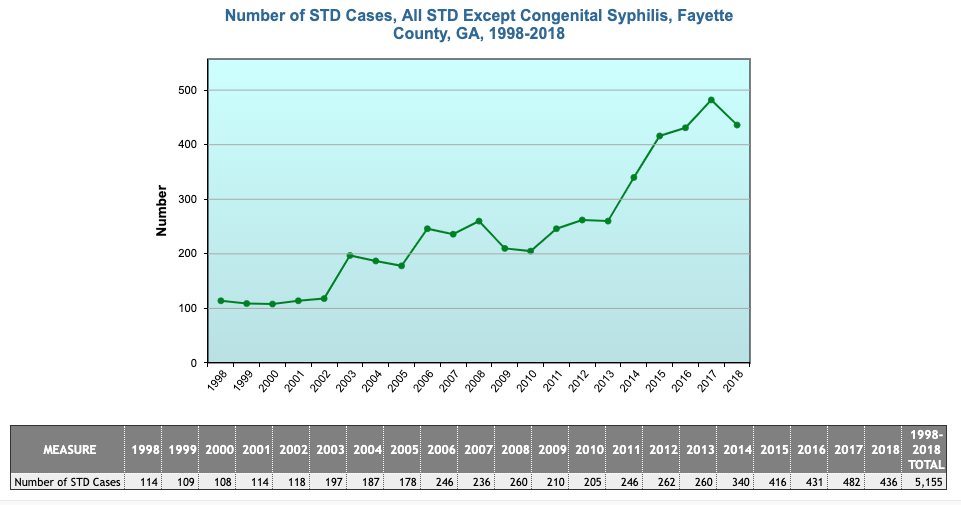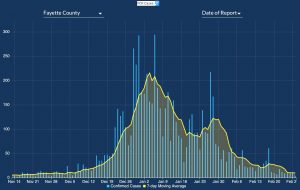A review of Sexually Transmitted Disease (STD) cases in Fayette County from 1998-2018 showed an increase from just over 100 cases in 1998 to more than 400 cases in 2018, with the largest jump between 2014-2018. The data showed chlamydia to be the predominant STD recorded in Fayette.
Data provided through OASIS, the Ga. Department of Public Health (DPH) Online Analytical Statistical Information System, covers the 20-year period of 1998-2018.
The 20-year trend for all STDs cases in Fayette, with the exception of congenital syphilis, showed Fayette with 114 cases of STDs in 1998, jumping in 2003 to nearly 200 cases, increasing again between in the low- to mid-200 case range from 2006-2013, then passing 300 in 2014 and passing 400 in 2015, where it remained in 2018.
Viewed over the 20-year period, the significant increase in STD cases grew much faster than did the population.
[STORY CONTINUES AFTER CHART]

Fayette County’s population in 2000 was 92,122, growing to 106,567 in 2010 and with an estimated population of 116,200 in 2018 – representing a 26 percent increase in population during the 20-year period.
While the data provided by DPH shows the numbers, there was no accounting for the causes in the increases over the 20-year period.
Though pertinent locally, it should be noted that Fayette’s occurrence of STDs, when viewed through a longer lens, is the lowest of metro Atlanta counties with similar population totals.
The data showed 108-118 STD cases annually from 1998-2002. An increase to 197 cases occurred in 2003, with that number decreasing to 187 in 2004 and 178 in 2005.
The numbers for all STDs in Fayette rose to 246 in 2006, decreased to 236 in 2007 and back up to 260 in 2008. The trend spiked downward in 2009 and 2010, hovering just above 200 cases, then spiked upward in 2011-2013, showing 246-262 cases during those years.
It was in 2014 that the STD numbers jumped significantly, reaching 340 cases. The number of cases in 2015 also rose again to 416. The number of cases rose slightly in 2016 to 431 cases, then jumped again to 482 cases in 2017. And in 2018, the most current reporting year, the number of STD cases decreased to 436.
Viewed by gender over the 20-year period for all STDs except congenital syphilis, the data showed cases pertaining to females at a 2:1 rate or higher compared to males. It should be noted, for example, that unlike women, men do not have a yearly PAP smear which will indicate issues such as STDs, and hence be reportable to the state system.
Pertaining to the data, and by way of example, there were 30 cases with males in 1998 compared to 84 female cases; 201 female cases in 2006 compared to 41 male cases; 183 female cases in 2013 compared to 75 male cases; and 263 female cases in 2018 compared to 170 male cases.
Viewed by age groupings during the 1998-2018 period, the 15-17 age group had a low of 14 cases in 2001 and a high of 39 cases in 2016.
In the 18-19 age group, there was a low of 17 cases in 1998 and a high of 97 cases in 2017.
In the 20-24 age group, the lowest number of cases came with 27 in 1998 and with a high of 201 cases in 2017.
The 25-29 age group had a low of 11 cases in 2001 and a high of 77 cases in 2018.
The age group for those 30-34 had a low of 5 cases in 2002 and a high of 34 cases in 2018.
In the 35-39 age group, there was a low of 5 cases in 2009 and a high of 20 cases in 2016 and 2018.
And in the 40-44 age group, there were no cases reported for many of the years in the 20-year period, and with the number of cases that were reported averaging less than 10, except 2016 and 2017, where there were more than a dozen cases.
Age data showed a negligible number of cases after age 44. Similarly, with the 10-14 age group, the only reportable year was in 2006 where there were 7 cases.
In terms of the specific STDs, chlamydia accounts for the largest number of cases during the 20-year period. The number of chlamydia cases totaled 83 in 1998, rising to 362 in 2018.
Data for gonorrhea a low of 28 cases in 1998, rising to 87 cases in 2016, 75 cases in 2017 and declining to 59 cases in 2018.
Data for early latent syphilis showed five cases in 2015 and seven cases in 2017, and less than five cases 12 of the other years during the 20-year report period.
Data for late latency syphilis showed five cases in 2014 and 2016, 11 in 2017 and eight in 2018. There were 14 other years during the period where fewer than five cases were documented.
The above data can be viewed at www.oasis.state.ga.us.













Leave a Comment
You must be logged in to post a comment.